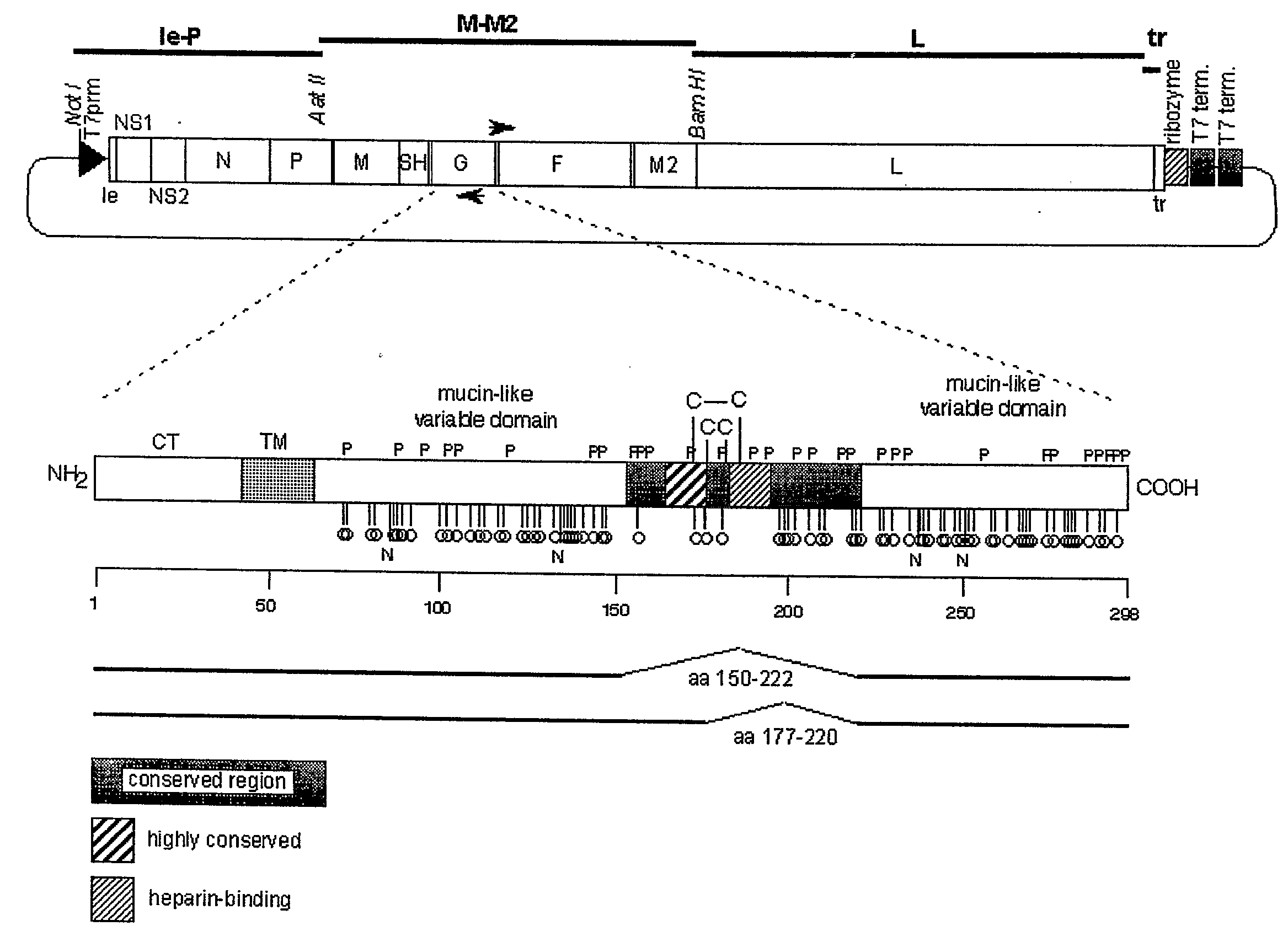Recombinant Rsv Strains With Altered G Protein
a technology of g protein and rsv, which is applied in the field of recombinantly generated, isolated, respiratory syncytial virus strains, can solve the problems of neither tactic so far producing an acceptable product, rsv imposes a significant burden on healthcare, and infants and toddlers are susceptible to wheezing
- Summary
- Abstract
- Description
- Claims
- Application Information
AI Technical Summary
Benefits of technology
Problems solved by technology
Method used
Image
Examples
example 1
Construction of Recombinant RSV Strains with Altered G protein
[0094] The recall responses of T cells from mice (15) and humans (16) against G protein appear to be directed primarily against epitopes within the ectodomain encompassed by amino acids 149 to 200. To diminish T cell responses to G protein and improve safety, anti-genomic cDNAs were constructed wherein nucleotides (nt) in this region were deleted (FIG. 1). From one cDNA, 123 nt (positions 5221 to 5344) encoding 41 amino acids (178 to 219) were deleted. The second cDNA was deleted of 210 nt (positions 5140 to 5350) that encoded 70 amino acids (151-221). The rRSV strains were rescued as previously reported (40) and respectively designated rA2cpΔG177-220 (SEQ ID NOS:3 and 4) and rA2cpΔG150-222 (SEQ ID NOS:1 and 2). The appropriate mutations for each rRSV strain were confirmed following consensus genomic sequencing of RT / PCR products spanning the entire genome. Additional alterations in the genome and gene for G protein were...
example 2
In Vitro Growth Characteristics of Recombinant RSV Strains Designated rA2cpΔG177-220 and rA2cpΔG150-222
[0097] Replication of the mutant viruses was characterized by qPCR and standard plaque assays using human lung epithelial cells (A549) cultured at 37° C. Table 2 shows results from a representative qPCR assay wherein temporal increases in RSV genome copy number following infection with rA2cpΔG177-220 or rA2cpΔG150-222 were contrasted with that of cp-RSV (parent virus), rA2cpΔG213 (40), wild-type A2, and temperature sensitive cpts248 / 404 (48) strains of RSV.
TABLE 2The replication of rRSV strains with genetically altered G protein in A549 lung epithelial cellsHours post infection24 h48 h72 hGroupaCopy #bFoldΔcPFUdCopy #bFoldΔcPFUdCopy #bFoldΔcPFUdrA2cpΔG150-14.21.223.046.12.040.570.02.1115.0222rA2cpΔG177-12.61.34.335.62.634.047.24.095.0220rA2cpΔG2133.25.10.00512.47.30.217.311.02.3A223.00.725.0101.90.9360.0183.51.02,700.0cp-RSV16.5—22.590.63—315.0189.4—3,300.0cpts248 / 4040.366.0ND0....
example 3
Immunogenicity and Efficacy of Recombinant RSV Immunogenic Compositions
[0101] The capacity of the genetically altered viruses to replicate in the respiratory tract was examined after experimental infection of BALB / c mice. The results indicated that deletion of amino acids 151 to 221 did not lead to restricted replication in vivo. The virus titers in lungs (FIG. 4A) and nasal (FIG. 4B) tissues four days after infection with rA2cpΔG177-220 or rA2cpΔG150-222 were not significantly less than that of the parent virus. As previously reported (49, 48), replication of cpts248 / 404 and rA2cpts248 / 404ΔSH viruses was severely limited in vivo. Because G protein is a major protective antigen, several studies were also performed to ascertain the capacity of rA2cpΔG177-220 or rA2cpΔG150-222 to induce efficacious immune responses in BALB / c mice. Four weeks after primary infection with rA2cpΔG177-220 or rA2cpΔG150-222, noteworthy serum complement-assisted neutralization titers were observed (Table 3...
PUM
| Property | Measurement | Unit |
|---|---|---|
| temperature | aaaaa | aaaaa |
| temperature | aaaaa | aaaaa |
| temperature | aaaaa | aaaaa |
Abstract
Description
Claims
Application Information
 Login to View More
Login to View More - R&D
- Intellectual Property
- Life Sciences
- Materials
- Tech Scout
- Unparalleled Data Quality
- Higher Quality Content
- 60% Fewer Hallucinations
Browse by: Latest US Patents, China's latest patents, Technical Efficacy Thesaurus, Application Domain, Technology Topic, Popular Technical Reports.
© 2025 PatSnap. All rights reserved.Legal|Privacy policy|Modern Slavery Act Transparency Statement|Sitemap|About US| Contact US: help@patsnap.com



